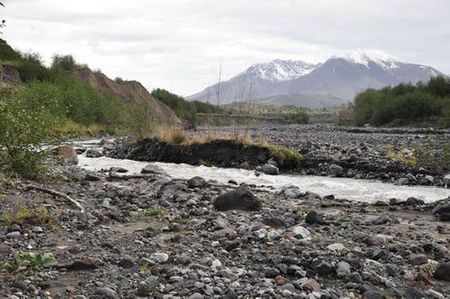A FREE integrated curriculum designed for 4th grade students aligned with Next Generation Science Standards.
Questions? Email learn@mshinstitute.org or call (360) 207-1777

Volcanic eruptions can produce large amounts of debris in the form of sediment. Volcanic sediment is a serious hazard that can flood river valleys, bury homes and wash out bridges and roads. In the 1980 eruption of Mount St. Helens, many billions of cubic meters of sediment flowed down from the mountain through the surrounding river valleys, which caused major flooding and damage to the homes of people living downstream.
In the “Sediment on the Move” storyline, fourth-grade students explore the hazards of volcanic sediment and solve the problem of managing these hazards. This robustly developed and problem-based learning unit supports teachers in creating a rigorous and rich experience for students through use of fully-developed teacher support resources (Google Slides for students ready to be used), rich media (videos, images, first-person narratives), and a plethora of engaging and 3-dimensional formative assessments.
Through various activities, scientific inquiry and exploration, students become acquainted with the size and scale of volcanic sediment as a long-term hazard for communities that live downstream of volcanoes. In this unit students design their own community and roleplay as city council members. Students collaborate with characters who model real-world career professionals (such as engineers, geologists and emergency managers) who help them design their own solutions to the problem of volcanic sediment. Through science, teamwork, and communication, students generate and compare multiple solutions to help their community be prepared for the hazards and challenges from volcanic sediment. At the end of the storyline, students create recommendations and design plans to share with other communities facing similar challenges.
This unit is aligned to the Next Generation Science Standards, Common Core ELA Standards, Common Core Math Standards, and Social Studies Learning Standards. This unit supports the Next Generation Science Standard Performance Expectation 4-ESS3-2. Generate and compare multiple solutions to reduce the impacts of natural Earth processes on humans. View the storyline map for more details on how each activity supports these standards.
Translations for student materials are available in Spanish, Russian, and Ukrainian. Please contact learn@mshinstitute.org if you need student materials translated into a different language or access to curriculum resources.
This unit is a result of a collaborative effort between the Mount St. Helens Institute and our partners.
The Cowlitz Tribe Education and Arts Fund, the Honorable Frank L and Arlene G Price Foundation, U.S. Forest Service, and individual donors.

This work is licensed under a Creative Commons Attribution-NonCommercial-ShareAlike 4.0 International License.
This unit also contains links to resources created by other organizations which may use a different license. Please make sure that you understand the terms of use of third-party resources before reusing them. Prior to publishing this unit of study, we have reviewed the content of this unit to ensure that all materials are in accordance with creative commons regulations. If you notice that a part of this unit infringes another’s copyright, please contact us at learn@mshinstitute.org.
Primary source materials including photographs, oral histories and other content was contributed to this project by the following organizations:
Join our learning list to receive the latest updates about our education programs, including registration openings, information about virtual and online education, and teacher trainings.